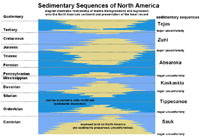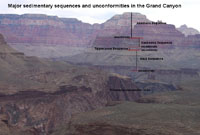2.5: Sedimentary Sequences Preserve the Fossil Record
- Page ID
- 9773
\( \newcommand{\vecs}[1]{\overset { \scriptstyle \rightharpoonup} {\mathbf{#1}} } \)
\( \newcommand{\vecd}[1]{\overset{-\!-\!\rightharpoonup}{\vphantom{a}\smash {#1}}} \)
\( \newcommand{\id}{\mathrm{id}}\) \( \newcommand{\Span}{\mathrm{span}}\)
( \newcommand{\kernel}{\mathrm{null}\,}\) \( \newcommand{\range}{\mathrm{range}\,}\)
\( \newcommand{\RealPart}{\mathrm{Re}}\) \( \newcommand{\ImaginaryPart}{\mathrm{Im}}\)
\( \newcommand{\Argument}{\mathrm{Arg}}\) \( \newcommand{\norm}[1]{\| #1 \|}\)
\( \newcommand{\inner}[2]{\langle #1, #2 \rangle}\)
\( \newcommand{\Span}{\mathrm{span}}\)
\( \newcommand{\id}{\mathrm{id}}\)
\( \newcommand{\Span}{\mathrm{span}}\)
\( \newcommand{\kernel}{\mathrm{null}\,}\)
\( \newcommand{\range}{\mathrm{range}\,}\)
\( \newcommand{\RealPart}{\mathrm{Re}}\)
\( \newcommand{\ImaginaryPart}{\mathrm{Im}}\)
\( \newcommand{\Argument}{\mathrm{Arg}}\)
\( \newcommand{\norm}[1]{\| #1 \|}\)
\( \newcommand{\inner}[2]{\langle #1, #2 \rangle}\)
\( \newcommand{\Span}{\mathrm{span}}\) \( \newcommand{\AA}{\unicode[.8,0]{x212B}}\)
\( \newcommand{\vectorA}[1]{\vec{#1}} % arrow\)
\( \newcommand{\vectorAt}[1]{\vec{\text{#1}}} % arrow\)
\( \newcommand{\vectorB}[1]{\overset { \scriptstyle \rightharpoonup} {\mathbf{#1}} } \)
\( \newcommand{\vectorC}[1]{\textbf{#1}} \)
\( \newcommand{\vectorD}[1]{\overrightarrow{#1}} \)
\( \newcommand{\vectorDt}[1]{\overrightarrow{\text{#1}}} \)
\( \newcommand{\vectE}[1]{\overset{-\!-\!\rightharpoonup}{\vphantom{a}\smash{\mathbf {#1}}}} \)
\( \newcommand{\vecs}[1]{\overset { \scriptstyle \rightharpoonup} {\mathbf{#1}} } \)
\( \newcommand{\vecd}[1]{\overset{-\!-\!\rightharpoonup}{\vphantom{a}\smash {#1}}} \)
\(\newcommand{\avec}{\mathbf a}\) \(\newcommand{\bvec}{\mathbf b}\) \(\newcommand{\cvec}{\mathbf c}\) \(\newcommand{\dvec}{\mathbf d}\) \(\newcommand{\dtil}{\widetilde{\mathbf d}}\) \(\newcommand{\evec}{\mathbf e}\) \(\newcommand{\fvec}{\mathbf f}\) \(\newcommand{\nvec}{\mathbf n}\) \(\newcommand{\pvec}{\mathbf p}\) \(\newcommand{\qvec}{\mathbf q}\) \(\newcommand{\svec}{\mathbf s}\) \(\newcommand{\tvec}{\mathbf t}\) \(\newcommand{\uvec}{\mathbf u}\) \(\newcommand{\vvec}{\mathbf v}\) \(\newcommand{\wvec}{\mathbf w}\) \(\newcommand{\xvec}{\mathbf x}\) \(\newcommand{\yvec}{\mathbf y}\) \(\newcommand{\zvec}{\mathbf z}\) \(\newcommand{\rvec}{\mathbf r}\) \(\newcommand{\mvec}{\mathbf m}\) \(\newcommand{\zerovec}{\mathbf 0}\) \(\newcommand{\onevec}{\mathbf 1}\) \(\newcommand{\real}{\mathbb R}\) \(\newcommand{\twovec}[2]{\left[\begin{array}{r}#1 \\ #2 \end{array}\right]}\) \(\newcommand{\ctwovec}[2]{\left[\begin{array}{c}#1 \\ #2 \end{array}\right]}\) \(\newcommand{\threevec}[3]{\left[\begin{array}{r}#1 \\ #2 \\ #3 \end{array}\right]}\) \(\newcommand{\cthreevec}[3]{\left[\begin{array}{c}#1 \\ #2 \\ #3 \end{array}\right]}\) \(\newcommand{\fourvec}[4]{\left[\begin{array}{r}#1 \\ #2 \\ #3 \\ #4 \end{array}\right]}\) \(\newcommand{\cfourvec}[4]{\left[\begin{array}{c}#1 \\ #2 \\ #3 \\ #4 \end{array}\right]}\) \(\newcommand{\fivevec}[5]{\left[\begin{array}{r}#1 \\ #2 \\ #3 \\ #4 \\ #5 \\ \end{array}\right]}\) \(\newcommand{\cfivevec}[5]{\left[\begin{array}{c}#1 \\ #2 \\ #3 \\ #4 \\ #5 \\ \end{array}\right]}\) \(\newcommand{\mattwo}[4]{\left[\begin{array}{rr}#1 \amp #2 \\ #3 \amp #4 \\ \end{array}\right]}\) \(\newcommand{\laspan}[1]{\text{Span}\{#1\}}\) \(\newcommand{\bcal}{\cal B}\) \(\newcommand{\ccal}{\cal C}\) \(\newcommand{\scal}{\cal S}\) \(\newcommand{\wcal}{\cal W}\) \(\newcommand{\ecal}{\cal E}\) \(\newcommand{\coords}[2]{\left\{#1\right\}_{#2}}\) \(\newcommand{\gray}[1]{\color{gray}{#1}}\) \(\newcommand{\lgray}[1]{\color{lightgray}{#1}}\) \(\newcommand{\rank}{\operatorname{rank}}\) \(\newcommand{\row}{\text{Row}}\) \(\newcommand{\col}{\text{Col}}\) \(\renewcommand{\row}{\text{Row}}\) \(\newcommand{\nul}{\text{Nul}}\) \(\newcommand{\var}{\text{Var}}\) \(\newcommand{\corr}{\text{corr}}\) \(\newcommand{\len}[1]{\left|#1\right|}\) \(\newcommand{\bbar}{\overline{\bvec}}\) \(\newcommand{\bhat}{\widehat{\bvec}}\) \(\newcommand{\bperp}{\bvec^\perp}\) \(\newcommand{\xhat}{\widehat{\xvec}}\) \(\newcommand{\vhat}{\widehat{\vvec}}\) \(\newcommand{\uhat}{\widehat{\uvec}}\) \(\newcommand{\what}{\widehat{\wvec}}\) \(\newcommand{\Sighat}{\widehat{\Sigma}}\) \(\newcommand{\lt}{<}\) \(\newcommand{\gt}{>}\) \(\newcommand{\amp}{&}\) \(\definecolor{fillinmathshade}{gray}{0.9}\)Sedimentary Sequences Preserve the Fossil Record
The history of the evolution of life is partly preserved in sedimentary rocks found around the world. The ancient history of a species is also preserved in the DNA of living organisms. Although the fossil record is extensive, there are many gaps in the fossil record where sediments of different ages have not been preserved in many regions, and much has been erased as ocean crust is destroyed in the processes involving plate tectonics (discussed in Chapter 4). Also, ancient sedimentary deposits on continental are destroyed by erosion. Despite these issues, sedimentary deposits representing all geologic ages are preserved and exposed in different places around the world. The fossil record is best preserved and represented by sedimentary deposits associated with ancient shallow marine and coastal environmental settings preserved and exposed in continental settings.
Transgressions and Regressions of Ancient Shallow Seas
Figure 2.13 shows how sea level rose and fell through the ages across North America. A transgression occurs when sea levels rise and shallow seas advance onto the margins of a continent. When sea level falls, the seas retreat and land is exposed—a process called a regression. For much of the last billion years shallow seaways transgressed onto the North American continent. Many minor transgressions and regressions also occurred, and shallow seas intermittently covered large portions of the continent. When sea level rose, sediments were deposited blanketing large regions of the continents. These deposits are preserved as sedimentary rock formations that accumulated in terrestrial, coastal, and marine depositional environments. Groups of these rock formations are parts of sedimentary sequences that preserve the fossil record.

Figure 2.13. Major sedimentary sequences of North America preserve some of the evidence of the fossil record (after Sloss, 1931). The Sauk Sequence is the oldest containing shell fossils of the Cambrian Period. Each sequence represents a major advance (transgression) of shallow seas and coastal environments. Major unconformities represent periods of regression (dominated by erosion when the seas withdrew).
Each of the sequences rests on the eroded surface on top of a previous sequence represented by a major regional unconformity (also called a sequence boundary, as illustrated in Figure 2.13). Six major sequences (with their underlying unconformities) are recognized throughout North America, with equivalent sequences and sequence boundaries on other continents. Each sequence represents a major marine advance (a transgressions) of shallow seas , replacing coastal plains and terrestrial environment. The major unconformities represent periods of regression (when the seas withdrew and coastal and terrestrial environmental setting replaced shallow marine environments).
Each of the sequences preserve fossils and evidence of biological activity that occurred when the sediments were deposited and preserved. Erosion through time has stripped away these deposits in many regions, but portions of each sequence are still still preserved and exposed in different parts of the continents. For example, part of four of the great sequences are exposed in the Grand Canyon (Figure 2.14). Sedimentary rocks bearing fossils from all geologic-time periods have been identified in locations scattered around the world.

Figure 2.14. Paleozoic-age sedimentary sequences exposed in the Grand Canyon, Arizona include portions of the Sauk, Tippecanoe, Kaskaskia, and Absaroka sequences (shown in Figure 2.13). Each sequence is bounded (above and below) by unconformities. The oldest sequence bearing an abundance of fossils is the Sauk Sequence that rests on top of the Great Unconformity, an erosional boundary between rocks of Precambrian and Cambrian age exposed in the deepest parts of the Grand Canyon.


